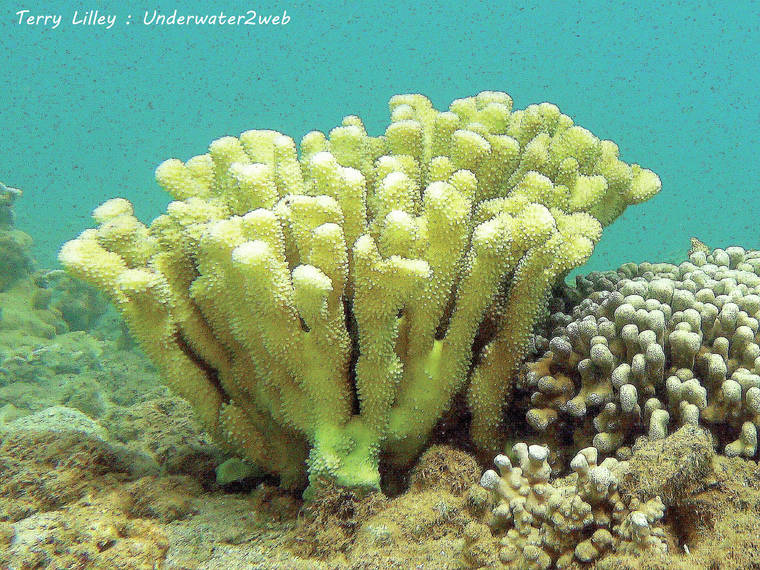Nothing on a Hawaiian coral reef is more impressive than a three-foot-tall antler coral. These large corals grow up out of the top of the lava reef, looking like giant underwater trees with spreading branches to capture the sun’s light. These corals can grow in very-shallow water right under where we snorkel or surf, but they can also grow down to 100 feet deep. Many of the antler corals are brown or green in color, but some shallow-water specimens can be yellow or purple. They are called “antler corals” because they look like the antlers on a moose.
Antler corals, along with all of the rock-hard “stony” corals, have a calcium-carbonate structure that protects the tiny clear, soft coral polyp.
Much like we have a soft body but build a strong, concrete house to protect ourselves from the elements, and we may build our stony homes on top of each other to form high-rise condominiums, the corals do the same thing.
They grow these hard, calcium homes one on top of another, which allows the coral to grow upwards and live for well over 100 years old.
Corals are animals, although they look more like plants. Each tiny coral polyp is like a little upside-down jellyfish, and lives in a small, hard home it produces. The polyps’ stinging tentacles protrude out into the sea water, sting small, floating animals, and pull them in for food. If the coral polyp becomes frightened it can retract into its hard home to be safe from predators like the parrot fish or butterfly fish that may try to eat them.
Antler corals look very similar to cauliflower corals, but they grow much taller and have more wide-spaced branches. They come in many colors. This is due to the algae farm that the coral polyps grow in their soft tissue. Much like we may grow a vegetable garden at home in our condominium, the corals grow algae called “zooxanthellae” that give the corals oxygen and sugars through the process of photosynthesis.
The UV sunlight does not penetrate into the sea much deeper than about 80 feet, and that is why most of the stony corals live in shallow water. Some corals grow green algae and some grow yellow or brown algae, which gives the corals their color.
Antler corals are very important to the health of the Hawaiian coral reef for many reasons. Their tall, wide branches offer a strong home to protect many small fish species, crabs, eels and other marine life.
These corals often grow right under the big surf, which causes the underside of the waves to drag on the reef and the wave to break, making a good wave to surf on. But the corals also play a very important part in making and protecting our beautiful Hawaiian beaches.
Ground up coral and shells make our white, sandy beaches. The tall antler corals also cause our giant surf to break on the outer reefs, keeping the energy of the waves from removing the beach. When the corals die, the energy of the surf hits the beach, tearing out the sand and causing beach-front homes to fall into the sea. This is why it is so important to protect Hawaiian coral reefs as they act as a natural seawall to protect our beaches, homes and coastal roads from excess erosion. A dozen giant antler corals growing on the reef out in front of a beach home can save the home from falling into the sea during large-surf events.
If we have a healthy coral reef that continues to grow, then that will offset the damage to our coastline due to rising sea levels. We once thought that the antler corals only grow upwards about an inch a year. Recently, I have been measuring the growth of our Kaua‘i antler corals for a new, artificial-intelligence, coral-reef monitoring program with Microsoft, and have documented the corals growing as much as eight inches a year.
It is important for coral reefs to be studied and protected in Hawai‘i, as they can die quickly due to pollution from sewage, farm chemicals, sunscreen, mud, over-tourism, rising sea temperatures, and even boat and military activity.
You can see all of the Hawaiian coral species at underwater2web.com. Children can enroll in a marine-science reef camp with the nonprofit reefguardianshawaii.org, where students are taught to conduct extensive coral-reef monitoring studies.
Aloha from under the waves.
•••
Terry Lilley, a marine biologist, lives in Hanalei. His websites include underwater-2web.com and gofundme.com/5urrm4zw.



